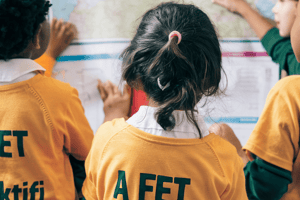Podcast
Questions and Answers
What is the main approach to investigating the natural and man-made world according to the text?
What is the main approach to investigating the natural and man-made world according to the text?
- Innovate and collaborate (correct)
- Analyze historical events
- Avoid all man-made products
- Engage in philosophical debates
What is a key characteristic of the goal of science teaching as described in the text?
What is a key characteristic of the goal of science teaching as described in the text?
- Promote superstitions
- Focusing only on theoretical concepts
- Exploring real problems in unique ways (correct)
- Encourage illogical thinking
What does science teaching aim to achieve by explaining phenomena scientifically?
What does science teaching aim to achieve by explaining phenomena scientifically?
- Breakdown the mindset of superstitious belief (correct)
- Avoid rational thinking
- Encourage superstitious beliefs
- Promote unscientific explanations
Which skill is emphasized in evaluating and designing scientific inquiry according to the text?
Which skill is emphasized in evaluating and designing scientific inquiry according to the text?
What does science focus on when dealing with real-life problems?
What does science focus on when dealing with real-life problems?
What is a characteristic of scientific inquiry according to the text?
What is a characteristic of scientific inquiry according to the text?
What does science teaching aim to assess in terms of credibility?
What does science teaching aim to assess in terms of credibility?
What is a key aspect of technology mentioned in the text when discussing man-made products?
What is a key aspect of technology mentioned in the text when discussing man-made products?
What does science offer according to the text when it comes to real-life problems?
What does science offer according to the text when it comes to real-life problems?
What is an essential part of exploring real problems in one's own way as mentioned in the text?
What is an essential part of exploring real problems in one's own way as mentioned in the text?
Flashcards are hidden until you start studying
Study Notes
- Key 1 Standard focuses on understanding object properties, describing basic living things needs, practicing science skills, and showing curiosity for the natural world.
- Key 2 Standard emphasizes conducting science experiments, using the right tools, noticing patterns, drawing conclusions, and sharing ideas to understand surroundings for health, environment care, and safety.
- Key 3 Standard highlights students demonstrating understanding of science, environment, and technology, enabling them to make informed decisions and solve real problems through experiments.
- Cognitive Load Theory advises against overwhelming students with information, knowing student limitations, ensuring significant learning for lasting retention, and engaging senses in learning.
- Teaching Approaches in Science include Inquiry-Based, Application-Led, Science-Technology-Society, Problem-Based Learning, and Multidisciplinary approaches for effective learning.
- Competencies of learners under the Science Curriculum include effective communication, critical and creative problem-solving, responsible nature stewardship, innovative thinking, informed decision-making.
- Big Ideas in Teaching Science cover concepts like structure and function, stability and change, system models, energy conservation, scale, proportion, patterns.
- Science Teaching involves knowing the discipline, investigating natural and man-made worlds, collaborating to explore and solve real problems, assessing credibility, and promoting unique ways of thinking and acting.
- Goals of Science Teaching include explaining phenomena scientifically, evaluating and designing scientific inquiry, breaking down superstitions with scientific explanations, and fostering creative and critical thinking.
Studying That Suits You
Use AI to generate personalized quizzes and flashcards to suit your learning preferences.




